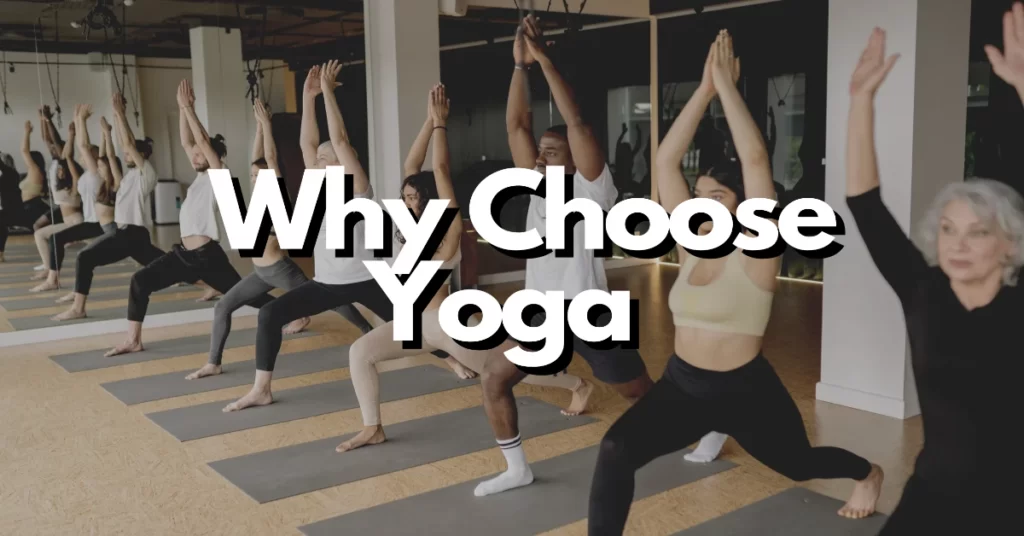In a world where stress, sedentary lifestyles, and health concerns are on the rise, the search for holistic well-being and inner balance has never been more critical. Many people explore various avenues to enhance their physical and mental health, including fitness routines, meditation practices, and wellness programs. One timeless practice that stands out among these alternatives is yoga.
Why Yoga?
Yoga is more than just a fitness trend or a relaxation technique. It’s a comprehensive approach to achieving harmony in mind, body, and spirit. Rooted in ancient traditions, yoga has endured the test of time and adapted to modern life, making it a versatile and accessible practice for people of all ages and backgrounds.
This article delves into why you should choose yoga over other alternatives, exploring the similarities and differences that set it apart as a powerful tool for well-being.
The Mind-Body Connection
Similarities:
- Meditation and Mindfulness: Mindfulness meditation is a shared element between yoga and some alternative practices. It fosters self-awareness, reduces stress, and enhances mental clarity.
- Stress Reduction: Yoga, like other alternatives, helps combat stress by regulating the body’s stress response through controlled breathing and relaxation techniques.
Differences:
- Physicality: Yoga is a highly physical practice that incorporates postures (asanas), enhancing physical strength, flexibility, and balance. Most alternatives focus solely on mental exercises.
- Breathwork: Pranayama, the practice of controlled breathing in yoga, is a hallmark that directly connects the breath with physical movement and emotional regulation. Many alternatives may not emphasize this as significantly.
Fitness and Flexibility
Similarities:
- Physical Fitness: Yoga, as well as alternative fitness routines, can improve cardiovascular health, muscle strength, and endurance.
- Body Awareness: Both yoga and alternatives enhance body awareness, helping individuals connect with their physicality and make healthier choices.
Differences:
- Functional Movement: Yoga’s emphasis on functional movements and balanced strength development differentiates it from some alternatives that may focus on isolated muscle groups.
- Variety of Styles: Yoga offers a wide range of styles (e.g., Hatha, Vinyasa, Ashtanga) tailored to different fitness goals, while alternatives often follow standardized routines.
Stress Reduction and Mental Well-being
Similarities:
- Stress Reduction: Both yoga and alternatives provide stress relief by promoting relaxation and encouraging mindfulness.
- Emotional Resilience: They help build emotional resilience, allowing individuals to better cope with daily challenges.
Differences:
- Holistic Approach: Yoga’s holistic approach, combining physical postures, breathwork, and meditation, provides a more comprehensive mental wellness strategy.
- Philosophical Guidance: Yoga incorporates philosophical and ethical guidelines (Yamas and Niyamas) that offer a deeper understanding of life and self.
Lifestyle Integration
Similarities:
- Mindful Eating: Both yoga and alternatives promote mindful eating habits, fostering a healthier relationship with food.
- Sleep Improvement: These practices often lead to better sleep quality and patterns.
Differences:
- Yoga Off the Mat: Yoga encourages the integration of mindfulness and conscious living into everyday activities, creating lasting lifestyle changes.
- Cultural and Philosophical Roots: Yoga’s cultural and philosophical foundation may provide a more profound sense of purpose and connection for practitioners.
Accessibility and Inclusivity
Similarities:
- Accessibility: Both yoga and alternative practices can be adapted to accommodate various physical abilities and mobility levels.
- Community: They often foster a sense of belonging and community among participants.
Differences:
- Universal Appeal: Yoga’s inclusive nature, with modifications and prop usage, makes it accessible to a broader audience compared to some alternatives that may have more specific requirements.
- Yoga Philosophy: The philosophical aspects of yoga, such as compassion and non-judgment, encourage an inclusive mindset.
The Role of Teachers and Instructors
Similarities:
- Guidance: Instructors in both yoga and alternative practices play a crucial role in providing guidance and ensuring safe and effective sessions.
Differences:
- Certification Standards: Yoga instructors typically undergo extensive training and certification, ensuring a deep understanding of anatomy, physiology, and the philosophy behind the practice. This might not be as standardized in some alternative practices.
- Emphasis on Tradition: Yoga instructors often incorporate traditional teachings and values into their classes, adding a spiritual dimension to the practice that is less common in alternatives.
Conclusion
While there are many effective alternatives to promote physical and mental well-being, yoga offers a unique combination of physical fitness, mental clarity, and spiritual growth. Its versatility, accessibility, and holistic approach make it an excellent choice for individuals seeking a comprehensive path to wellness.
By choosing yoga, you open the door to a transformative journey that not only nurtures your body but also enriches your soul. So, take that step onto the yoga mat, and let the journey towards well-being begin.

